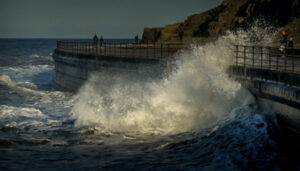If you’ve ever seen a boardwalk lined with business or coast with housing developments nearby, you’ve probably noticed the beautiful decorative-looking wall of stones in place to separate the sea from the establishments. These structures may seem like aesthetic choices, but they also serve an important function. By building low walls like these around properties, a protective barrier is formed to shield the foundation from erosion. Because of the importance of these walls, keeping them properly serviced is very important for their ensured longevity.
Appearance and Utility
Seawalls come in few various styles and materials, depending on your needs and the appearance you desire for the utility to blend well with the scenery. Having a shoreside property for a business can provide a wonderful atmosphere and bolster your traffic from visiting parties looking for some fun in the water. This does, however, present you with unique maintenance needs. One of these location-specific needs is the construction and repair of seawalls that frame a shoreline to protect foundations from waves. They can also help with guarding against potential flooding for areas near rivers or other bodies of water that see a lot of rainfall annually.
See the effects of harsh seas on shorelines by clicking this link: https://www.huffingtonpost.co.uk/2014/02/06/dawlish-railway-line_n_4735823.html
Constructed properly, and with adequate care, seawalls can last up to fifty years. Made from materials that can withstand the beating ocean waves and corrosive salt, they can ensure the safety of a location from otherwise dangerous tides. Be it high winds driving waves up the beach, a strong current causing constant soil erosion, or seasonal weather like hurricanes, flooding, and tsunamis, seawalls are important safeguards against the threats of any bodies of water.

Material options for aesthetic and defense
One of the more common materials used is concrete. Poured into blocks and anchored into bedrock, concrete seawalls are simple and effective installations to serve the purpose you need and are excellent in cost-effective utility. Large cobble or boulder barriers are more decorative as a seawall, and you may even see them used inland. With a nicer appearance made of stone, these can add visual appeal while still serving their purpose of protecting the land from the sea. Find out what professional installation can do to help your seaside business or home by contacting Salt of the Earth Inc.
You can also consider sheet pile seawalls. Sheet pile is a seawall, essentially a metal wall partition, which is installed against a bank for support and anchored deep in the soil for added stability. Another material for seawalls is riprap, chunks of concrete and stone that give a look like carefully laid stone built into the land. A simple solution with a clean appearance, it functions well to cover long coasts without sacrificing aesthetics. They’re fantastic for preventing erosion of soil along beaches that sea moderate waves or winds.
There are two styles of seawall you can make use of depending on what you need. One style is a curved wall, which follows the natural shore that is intended to recreate the pattern in which waves crash into the beach. The other style of wall is called gravity, which is anchored where the ground meets the water and typically reinforced to prevent stress fractures, as it’s incredibly rigid and susceptible to sheering from erosion. The success of either of these installations rely heavily on the materials used, as well as the quality and stability of the deep earth wherever the barrier is erected.
Defense against the elements
One of the more common causes of erosion on seawalls, about which you can find more info on this site, is when the soil it is supporting isn’t packed tightly enough to match the force of pressure being put on the structure from the ocean. This causes additional stress on the barrier in uneven ways and wears down the strength of certain sections faster than others that are better supported by more tightly packed earth. Another contributor to the erosion of seawalls is the wind and salt in seawater, wearing down the concrete and stone of the barriers over time. Keeping seawalls well maintained and repaired is vital to ensuring the safety of the property they protect.

Resisting storm surges by protecting the shoreline, built as high as the dunes where the beach meets land, these structures differ from another form of coastal protection called a breakwater. Sometimes called a jetty, these permanent fixtures are built into the sea, perpendicular to the coastline. By design, they help prevent erosion from prop washes and any wind-driven waves. These can also be used for vehicles to access certain areas, or as a walkway. While helpful in serving the purpose of protecting against erosion, breakwaters don’t offer the same defense for the actual coast itself, where businesses and homes are built.
A history of effectiveness
For guarding coastal and seaside settlements, seawalls have been what we use for thousands of years. Dating back as far documented as 195 AD in Byzantium, which we now know as Istanbul, parts of this seawall are still in place today. There is even a 220-year-old seawall located in India that defended the historic center threatened by the Indian Ocean tsunami that took place the day after Christmas in 2004. Many countries around the globe have and still use seawalls as defense and protection from ocean storms. With a time-tested and proven effectiveness at reducing damages from major weather events, storm cells, and long-term erosion damage, seawalls serve as the simplest solution for protection.
With expert help for installation and careful upkeep on repairing the barrier, you can ensure the longevity and safety of your structures. Establishing a business near the beach, or building a home or settlement to sit beside the sea, you need only decide on the materials and design you desire for the seawall you need to guard your coast from crashing waves and raging weather.




























